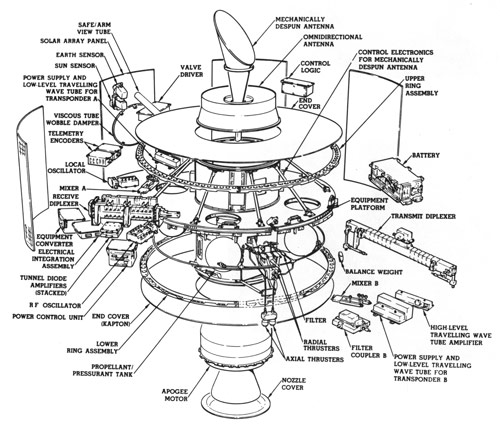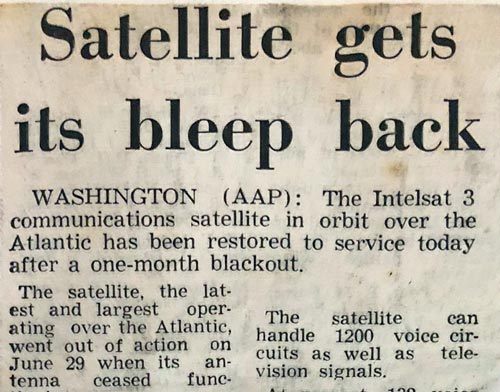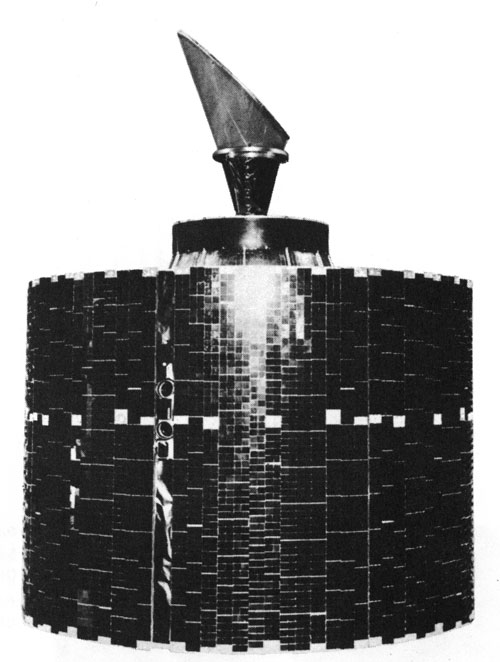It was planned to relay the Apollo 11 EVA TV across the Atlantic Ocean from the USA to Europe via the new Intelsat III-F2 communications satellite.
This would have meant that television released from Houston would be sent to the US television networks in New York.
From New York the signal would have travelled via terrestrial circuits to the Comsat terminal at Andover in Maine, then via the Atlantic Ocean Intelsat III F-2, to Goonhilly Down in the UK and Raisting in West Germany.
Things did not go to plan, however.
The Intelsat III series were capable of relaying 1200 two-way voice circuits or up to 4 television channels, with multiple access. They were spin stabilised with a despun antenna platform, the first communications satellites to use such a system. It was this antenna platform which caused problems shortly before the launch of Apollo 11.
The Intelsat III global satellite system
The Atlantic Ocean Intelsat III F-2 (designated 1968-116A) had been launched aboard a Thor Delta M launch vehicle on the evening of 18 December 1968, US time, to a geostationary position above Brazil to allow communications across the Atlantic Ocean.
The corresponding Indian Ocean satellite, Intelsat, III F-3, (designated 1969-011A), was launched six weeks later, on 05 February 1969, US time.
The Pacific Ocean satellite, Intelsat III-F-4, (designated 1969-045A), was launched on 21 May 1969, US time. (1)
This three satellites completed the global Intelsat III network just in time for the lunar landing attempt.
|
This artist’s impression of an Intelsat III above Australia was printed in a 1969 OTC booklet. The Intelsat III series were advanced communications satellites, but the mechanical despin assembly caused problems.
Preserved and scanned by Colin Mackellar. |
|
Intelsat III exploded view.
From an OTC booklet. Courtesy Jim Simpson, scan by Colin Mackellar. |
Atlantic Ocean satellite failure
The Atlantic Ocean satellite (III F-2) experienced problems with its Mechanical Despin Assembly. On 29 June 1969, the antenna platform apparently jammed, and the satellite was rendered unusable.
A replacement satellite, Intelsat III F-5 was launched late on 25 July 1969, just after Apollo 11’s return from the Moon, however it failed to achieve geostationary orbit, and was also unusable.
The failure of the Atlantic satellite (III F-2) meant that its planned use to relay television of the Apollo 11 EVA across the Atlantic was not possible.
Partial service of III F-2 was restored by late July, allowing the use of 264 voice circuits, and full service was restored on 01 August.
During Apollo 11
During Apollo 11, voice circuits across the Atlantic were routed through Early Bird (Intelsat I), which was brought back into service, and also the Atlantic Intelsat II.
Television between North America and Europe was sent westwards, over the Pacific and Indian Oceans.
Hence, the Jamesburg, California, Satellite Earth Station sent television up to Intelsat III F-4, over the Pacific. (The TV from Honeysuckle Creek and Parkes had already come to the Jamesburg via that satellite, so it was now relaying the TV incoming to, and outgoing from, Houston.)
These signals were received at Japan's KDD Ibaraki Satellite Earth Station, and then via the Japanese terrestrial network (operated by NTT) to Yamaguchi Satellite Earth Station (operated by KDD) facing the Intelsat Indian Ocean Region (IOR) satellite.
From Yamaguchi, it was relayed up to the Intelsat III F-3 satellite over the Indian Ocean, and then down to the British Post Office’s Goonhilly Downs Satellite Earth Station in Cornwall for the UK and for distribution across Europe by the European Broadcasting Union.
This arrangement was used for the Apollo 11 EVA television.
Therefore, the pictures seen in the United Kingdom and Europe (and then relayed into Eastern Europe) had travelled through three satellite links (six hops – one up and one down for each satellite – more than 215,000km in all).
For most of the EVA, the television signal was from Honeysuckle Creek and Parkes.
1.) After being sent by terrestrial microwave links to Sydney, and from there to the OTC Moree Satellite Earth Station, the picture was relayed via Intelsat III F-4 to Jamesburg Satellite Earth Station in California, and then by terrestrial routes to Houston.
2.) The picture released from Houston was sent by microwave link to New York, where the US TV networks distributed it across North America.
3.) That same signal was sent from New York, across the USA to Jamesburg SES, California, where it was transmitted back up to Intelsat III F-4, above the Pacific, (remember, it could handle up to 4 televsion channels simultaneously), and then down to Japan – then across Japan from Ibaraki to Yamaguchi. From Japan, it went up to Intelsat III F-3 over the Indian Ocean, and then was received at Goonhilly and Raisting for distribution through the British and EBU networks. (I understand that Goonhilly supplied the EBU pool feed.)
|
Here’s a diagram showing the signal path
Click the image for a PDF file. |
The result of all this switching was that viewers in Eastern Australia saw the best quality pictures, even though the picture had gone through two scan conversions.
West Australians saw the same picture which was being sent to Houston from Moree, though it was scan converted to 625 lines in Perth. (Story here.)
North Americans saw a slightly degraded picture, while those in Europe saw a significantly less-stable picture which had been degraded by multiple satellite hops and terrestrial microwave and other links, as well as double scan-conversion. (Nevertheless, millions of people in the UK and Europe were thrilled with what they saw!)
South America saw the broadcast via Early Bird (Intelsat 1) which had been brought back into service for that purpose.
[Planned: video comparisons of the TV quality as seen in Sydney; Houston; Europe.]
Footnotes / Background Sources:
(1) Jonathan McDowell’s Space Report – list of launches for the satellite launch dates.
(2) From the 16 July 1969 edition of Variety, (First Man on the Moon Has TV Networks in Orbit) come these details about the changes which had been necessitated by the failure of the Atlantic Intelsat III:
“For broadcasters in Asia and Europe the signal then travels back to Jamesburg, Calif., from where it goes up on the Pacific satellite on its way to a Japanese ground station, and then travels across land lines in Japan to a second ground station; from there to an Indian Ocean satellite and thence to the European Broadcasting Union ground station in Raisting, Germany. All this, too, in just a fraction of a second (a circuitous path necessitated by the trouble that developed recently in the Atlantic satellite).”
(Thanks to John Sarkissian for the link.)
(3) This newspaper clipping from a West Australian newspaper:
|
This undated clipping from a Perth, Western Australia, newspaper refers to the Intelsat III F-2 (Atlantic) failure.
Click for a PDF file of the full clipping. Preserved by Steve Chase. |
The above report explains, “The satellite, the latest and largest operating over the Atlantic, went out of action on June 29 when its antenna ceased functioning.”
It also explains the arrangements made for North America / Europe satellite communications while Intelsat III F-2 was out of action:
“During the blackout period, the Communications Satellite Corporation used the Early Bird and Intelsat 2 Atlantic satellites for telephone communications between Europe and North America and routed television signals over the Pacific and Indian Oceans.”
Lastly, the clipping, while undated, mentions the replacement Altantic Intelsat III F-5 – which was launched on 25 July 1969 – had failed the previous week. So this clipping seems to be from the week ending 2nd August 1969.
(4) The author has a recollection – from during the live broadcast of the Apollo 11 EVA – of hearing one of the commentators explain that TV to Europe was going the long way around, via the Pacific and Indian Oceans. (Does anyone know who that was? Walter Cronkite perhaps? Contact.)
(5) It’s worth noting the satellites were sometimes also referred to by letter designations:
Intelsat III F-2 was also known as Intelsat IIIB.
Intelsat, III F-3 was also known as Intelsat IIIC.
Intelsat, III F-4 was also known as Intelsat IIID.
Intelsat, III F-5 was also known as Intelsat IIIE.
(6) “COMSAT News”, August 1969.
|
Intelsat III
From an OTC booklet. Courtesy Jim Simpson, scan by Colin Mackellar. |
Back to the main Apollo
11 TV page.
Back
to the main Apollo 11 mission page.




